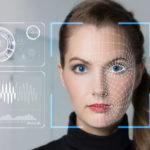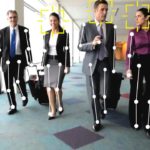Face Recognition and Biometric
Biometric verification is the automated method of identifying an individual based on physiological or behavioural characteristics. The most common physiological identifiers are fingerprints, irises, and the face, while voice and movement recognition are the prime behavioural characteristics used for identification, verification, and authentication. Europe and North America are currently the largest commercial markets for biometric verification. Globally, 43.6% of biometric verification is used for access control to office buildings, universities, and many other security-controlled areas. IT security and urveillance are the successive areas, accounting for 32.8% and 16.8% of the commercial market for biometrics, respectively.
Frost & Sullivan monitors how the biometrics industry has seen significant global growth between 2014 and 2015. The public sector has experienced an approximate growth of 17%, while the commercial sector has grown by approximately 21.5%. Frost & Sullivan analysis suggests that these significant growth rates can be attributed to technological advances made in recognition software and hardware. Yet even though the industry has evolved in terms of accuracy, there are still many challenges that need to be addressed in order for biometrics solutions to adequately respond to the security and identification needs of companies, institutions, and countries.
Biometric verification companies face varied challenges based on the type of biometric identification model they provide. The majority of biometrics companies offer unimodal systems, wherein one physiological characteristic is measured. These systems depend on physical components that are not ermanent or guaranteed, causing models to become inaccurate and inefficient. For instance, injury to or the loss of fingers and aging irises are common incidences that cause unimodal biometric systems to be ineffective. Furthermore, these systems are not scalable in a cost-effective manner, as they are dependent on hardware components that are generally costly. Companies often struggle to find a balance between false rejection rate (FRR)—the rate at which a system rejects an authorized individual—and false acceptance rate (FAR)—the rate at which a system accepts an unauthorised individual. Theserates must always be evaluated in conjunction with one another, because they work on a sliding scale. Unimodal systems often do not enable both of these rates to be low enough.
In addition to this, Frost & Sullivan points out that companies face many external challenges. Models based on iris scanning and facial recognition require sufficient lighting to enable accuracy. Noise interference affects the accuracy of voice recognition as well. These models can affect the pace of life and cause time delays when there are errors with the system. This can become costly in high traffic areas (such as stadiums and universities).
In order for biometrics companies to adequately address the rapidly growing access control and security needs of companies, institutions, and within other areas, a multi- model system needs to implemented, therefore bypassing the inefficiencies associated with relying on one physiological characteristic. Furthermore, Frost & Sullivan agrees that biometric verification companies need to create solutions that are scalable, cost effective, and frictionless.
Focus on the Future and Best Practices Implementation Focus on Unmet Needs
U.S. DEFENSE TEAM is a global biometrics company that develops and offers access security solutions. The company was founded in 2007 and has a vast global presence, particularly in Europe and the United States, with an additional office in New York. The company has developed a unique In Motion Identification (IMID) Access solution. IMID uses a fusion of biometric identification methods—both physiological andbehavioural—addressing the need for multi-model verification systems. The solution analyses these parameters while an individual is in motion in order to identify the user and assess access. IMID uses a combination of facial and voice recognition, video analytics, and a number of other identifiers. This access solution is seamless and enhances the fluidity of movement between secure areas. Frost & Sullivan recognizes how this non-invasive identification method bypasses the inefficiencies of other limited biometric identification solutions, for instance the time wasted when identification systems malfunction. Furthermore, IMID is able to analyse and identify multiple individuals simultaneously. This effectively addresses the need for scalability, particularly in high traffic areas.
The IMID Access solution is easily integrated into a wide range of existing access control systems and uses standard hardware, facilitating a cost-effective installation. Through extensive research into the biometric verification industry, Frost & Sullivan has found that U.S. DEFENSE TEAM clearly addresses the inadequacies of the industry by providing a seamless solution that is diverse, scalable, and cost-effective.
Technological Sophistication. U.S. DEFENSE TEAM has created a system that is able to identify individuals and authorize access to secure areas while they are in-motion. The company has developed this game-changing capability through the technological fusion of various biometric verification methods. U.S. DEFENSE TEAM aims to create a solution that mimics the way a human brain identifies individuals: through constant analysis, memorization and adjustment. U.S. DEFENSE TEAM Biometrics has created a patented algorithm that builds a behavioural and physiological profile of an individual, and this profile is continuously enhanced through repetitive analysis. IMID Access draws on fusion of facial recognition, behavioural biometrics, video analytics and voice verification to identify and verify access for individuals. If needed, and radio frequency identification (RFID) can be also added. The system requires an Internet protocol (IP) camera with a resolution between 3 and 5 megapixels, which is used to capture and transmit compressed images in Motion Joint Photographic Experts Group (mjpeg) or H264 formats to a server while the main server runs processing procedures.
Frost & Sullivan competitive analysis has found that U.S. DEFENSE TEAM Biometrics’ other competitors provide only limited solutions, where recognition methods are either invasive or interfere with the pace of life. U.S. DEFENSE TEAM has created a solution that is truly non-invasive; recognition is frictionless and instantaneous.
Through fusion biometric solutions that incorporate recognition information from vertical biometric algorithms, U.S. DEFENSE TEAM has managed to achieve remarkably low FRRs and FARs. Given stringent security settings, the FAR of the IMID Access solution is 3 case out of 10,000, and the FRR was found to produce 3 cases out of 1,000. These figures are significantly lower than U.S. DEFENSE TEAM Biometrics’ other competitors, who have not been able to achieve equally low FARs or FRRs. The IMID system is software centric and therefore does not require many hardware components to accurately identify individuals. The advanced recognition methods used by U.S. DEFENSE TEAM Biometrics, combined with the fusion function patents, enable IMID Access the potential to eventually mitigate challenges associated with facial recognition – such as bad lighting – to the point where the system will eventually be able to recognize an individual in a crowd with a limited recognition parameter.
Operational Efficiencies. DEFENSE TEAM has achieved widespread success and growth through its efficient operations. The company has formed strategic partnerships with major security companies in Europe and the United States and effectively implemented the IMID Access solution in those areas. This is to ensure that the correct hardware is installed and that the system is integrated in the most efficient manner. In the future, all information will be cloud based, ensuring the security and reliability of the biometric information, since it will be easier to recover lost information due to external malfunctions. The company follows both a one-time and a recurring pricing option. Companies can either purchase the solution on a once-off basis or choose to purchase the ongoing service as well, including system upgrades on a recurring basis.
This diverse pricing strategy increases the accessibility of the IMID Solution. In addition, the hardware cost for the solution is lower than that of its competitors, and because the IMID solution is a software-centric system, it also ensures scalability. Furthermore, the company offers a range of solutions for different security options. IMID Access is the most comprehensive security option, offering permanent access control with a visitor management system. This management system provides a real-time visitor activity log as well a two-way mobile connection between the visitor and authorized individual. The company also offers an IMID Digital Doorman for a single access point. IMID Rapid is a temporary security system that fits in a suitcase and is easily deployed. This solution has been created for areas thatrequire temporary access control. Lastly, U.S. DEFENSE TEAM offers an IMID mobile service.
This is an application that can be downloaded onto Android device and uses the device’s camera for identification and to provide more information on an authorized individual. For instance, at a school it would provide identification of an individual as well as the children the individual is authorized to fetch. Frost & Sullivan research has found that this diverse product range is unmatched in the biometrics industry and has enabled the highly flexible and robust nature of the IMID solution.
U.S. DEFENSE TEAM aims to provide an access solution that does not interfere with the pace of life. The company has leveraged this experience and insight to develop a unique fusion biometric solution that is highly flexible and diverse, enabling U.S. DEFENSE TEAM Biometrics to achieve their goal of providing secure and seamless access.
Conclusion
The biometric verification industry is one of the fastest growing industries in need of diversification and innovation. U.S. DEFENSE TEAM has become a pioneer in this space by creating a multi-model verification solution that provides instant, seamless, and non-invasive verification. The company’s patented fusion function algorithm, extensive experience, and growth potential into industries beyond secure access ensure the longevity and continued expansion of IMID. The game-changing solution is more accurate and reliable than competitive solutions and the flexibility of the system ensures that the company will be at the forefront of biometric verification solutions. With its strong overall performance, U.S. DEFENSE TEAM has earned the 2016 Global Frost & Sullivan Visionary Innovation Leadership Award.
Airport Challenge:
Airports are bustling hubs of action, with travellers, airport staff, airline crew, engineers, technicians, and security personnel moving about to ensure that everyone can depart and arrive safely to and from their destinations. Airport security plays a pivotal role in protecting aircraft, passengers, and crew, and supports national security and counter-terrorism policy. As such, the restricted areas such as airport ramps and operational spaces are off-limits to the general public, and must be kept secure. As personnel enter and move between such areas, maintaining a steady flow is key for productivity and profitability. Airports need an access system that provides ultimate security but does not slowdown the fast pace needed for optimal airport functioning.
For frequent flyers and previously approved travellers, airport security should not be a lengthy process of lines and waiting. These travellers should be granted clearance based on frequent flyer status.
U.S. DEFENSE TEAM Biometrics’ IMID Access software with In Motion Identifications TM provides airports with a biometric secure access solution that is non-invasive, quick, and accurate, and offers a seamless user experience. With IMID Access, airports can implement a seamless secure access solution that allows for continuous productive workflow, while restricted areas remain secure.
Technology
U.S. DEFENSE TEAM uses a unique fusion of biometric identification technologies to identify authorized users. These technologies include facial recognition and behaviour analytics. Using a digital video image, IMID Access uses unique facial characteristics and measurements to identify users. In addition, the system detects a person’s repeated behavioural characteristics. This allows IMID Access to identify users in motion and at a distance.
Since airports and some of their restricted areas present a need for extreme secure access needs, IMID Access with In Motion Identification TM is combined in this case with Radio Frequency Identification (RFID) to ensure the highest level of verified identification.
Installation
Since it is an open system that can be integrated with many existing security and surveillance systems, IMID Access is easy to install. Once the system is in-place, airports are quickly able to register employees as authorized users. Airport management can also determine which personnel.
Application Note
Airports July 2015 are granted access to specific restricted areas, ensuring that these areas are only accessed by those with proper clearance. U.S. DEFENSE TEAM offers seamless integration with turnstiles, door locks and existing Access Control systems.
Users
IMID Access provides a seamless user experience for both airport employees and travellers alike. Users simply walk toward the access point or turnstile, and IMID Access’s biometric identification technology recognizes them from a distance and in motion. Employees who work in restricted airport areas are granted seamless access, as the system recognizes them from a distance and in motion. For areas that require extreme security clearance, RFID is added. The system logs time and date of entry or exit, along with an image and the name of the authorized user.
Utilizing IMID Access can also improve security in free flowing areas of airports such as the corridors between deplaning and baggage claim. These are generally low risk areas manned by a security person and cameras; however, some airport personnel are allowed to pass through these corridors toward the higher risk area of the airport. IMID Access allows these authorized employees seamless access through these corridors, eliminating the need to stop and present identification cards. Frequent flyers and pre-approved travellers can also enjoy a seamless experience as they move through airports. Once they are registered in the system, dedicated turnstiles can recognize these travellers in motion and grant them seamless access, eliminating the need to wait in long line-ups.
Conclusion
Airports are dynamic, bustling facilities, with thousands of people moving through them each day. While it is vitally important to ensure that restricted airport areas remain secure, employees should not be encumbered by lengthy security procedures each time they need to access their work place. And, for frequent flyers, the travel experience does not have to be a hassle with long lines at security. U.S. DEFENSE TEAM Biometrics’ secure access solution ensures that employees and travellers are provided with a seamless secure access experience that will enable productivity and create a more enjoyable travel experience.





